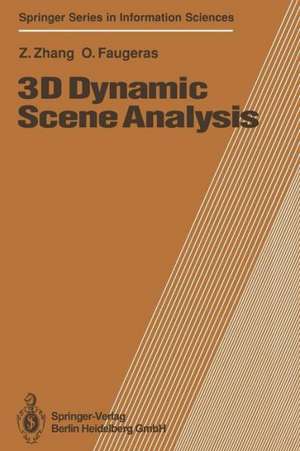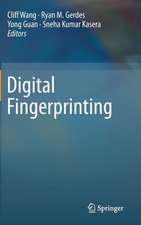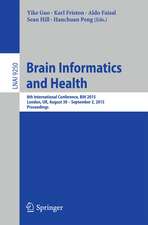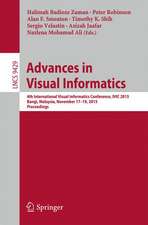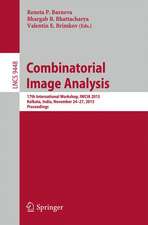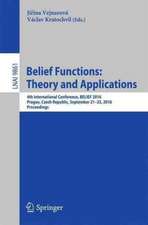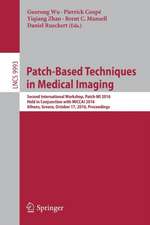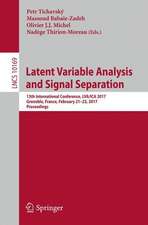3D Dynamic Scene Analysis: A Stereo Based Approach: Springer Series in Information Sciences, cartea 27
Autor Zhengyou Zhang, Olivier Faugerasen Limba Engleză Paperback – 14 oct 2012
Din seria Springer Series in Information Sciences
- 20%
 Preț: 337.66 lei
Preț: 337.66 lei - 18%
 Preț: 955.08 lei
Preț: 955.08 lei - 15%
 Preț: 646.62 lei
Preț: 646.62 lei - 20%
 Preț: 337.52 lei
Preț: 337.52 lei -
 Preț: 385.62 lei
Preț: 385.62 lei -
 Preț: 381.98 lei
Preț: 381.98 lei -
 Preț: 391.61 lei
Preț: 391.61 lei - 20%
 Preț: 324.64 lei
Preț: 324.64 lei -
 Preț: 380.84 lei
Preț: 380.84 lei - 18%
 Preț: 777.69 lei
Preț: 777.69 lei -
 Preț: 387.96 lei
Preț: 387.96 lei -
 Preț: 396.62 lei
Preț: 396.62 lei - 20%
 Preț: 330.75 lei
Preț: 330.75 lei -
 Preț: 382.57 lei
Preț: 382.57 lei - 15%
 Preț: 642.18 lei
Preț: 642.18 lei - 15%
 Preț: 640.06 lei
Preț: 640.06 lei -
 Preț: 387.58 lei
Preț: 387.58 lei -
 Preț: 386.99 lei
Preț: 386.99 lei - 20%
 Preț: 653.71 lei
Preț: 653.71 lei - 15%
 Preț: 661.02 lei
Preț: 661.02 lei - 18%
 Preț: 1391.21 lei
Preț: 1391.21 lei - 15%
 Preț: 638.43 lei
Preț: 638.43 lei - 15%
 Preț: 642.68 lei
Preț: 642.68 lei -
 Preț: 386.00 lei
Preț: 386.00 lei - 20%
 Preț: 649.60 lei
Preț: 649.60 lei - 18%
 Preț: 950.21 lei
Preț: 950.21 lei -
 Preț: 393.35 lei
Preț: 393.35 lei - 20%
 Preț: 652.41 lei
Preț: 652.41 lei - 20%
 Preț: 645.65 lei
Preț: 645.65 lei -
 Preț: 390.25 lei
Preț: 390.25 lei -
 Preț: 387.96 lei
Preț: 387.96 lei - 15%
 Preț: 580.97 lei
Preț: 580.97 lei
Preț: 333.40 lei
Preț vechi: 416.75 lei
-20% Nou
Puncte Express: 500
Preț estimativ în valută:
63.80€ • 68.22$ • 53.19£
63.80€ • 68.22$ • 53.19£
Carte tipărită la comandă
Livrare economică 17 aprilie-01 mai
Preluare comenzi: 021 569.72.76
Specificații
ISBN-13: 9783642634857
ISBN-10: 3642634850
Pagini: 316
Ilustrații: XI, 300 p.
Dimensiuni: 155 x 235 x 17 mm
Greutate: 0.45 kg
Ediția:Softcover reprint of the original 1st ed. 1992
Editura: Springer Berlin, Heidelberg
Colecția Springer
Seria Springer Series in Information Sciences
Locul publicării:Berlin, Heidelberg, Germany
ISBN-10: 3642634850
Pagini: 316
Ilustrații: XI, 300 p.
Dimensiuni: 155 x 235 x 17 mm
Greutate: 0.45 kg
Ediția:Softcover reprint of the original 1st ed. 1992
Editura: Springer Berlin, Heidelberg
Colecția Springer
Seria Springer Series in Information Sciences
Locul publicării:Berlin, Heidelberg, Germany
Public țintă
ResearchCuprins
1. Introduction.- 1.1 Brief Overview of Motion Analysis.- 1.2 Statement of the “Motion from Stereo” Problem.- 1.3 Organization of The Book.- 2. Uncertainty Manipulation and Parameter Estimation.- 2.1 Probability Theory and Geometric Probability.- 2.2 Parameter Estimation.- 2.3 Summary.- 2.4 Appendix: Least-Squares Techniques.- 3. Reconstruction of 3D Line Segments.- 3.1 Why 3D Line Segments.- 3.2 Stereo Calibration.- 3.3 Algorithm of the Trinocular Stereovision.- 3.4 Reconstruction of 3D Segments.- 3.5 Summary.- 4. Representations of Geometric Objects.- 4.1 Rigid Motion.- 4.2 3D Line Segments.- 4.3 Summary.- 4.4 Appendix: Visualizing Uncertainty.- 5. A Comparative Study of 3D Motion Estimation.- 5.1 Problem Statement.- 5.2 Extended Kalman Filter Approaches.- 5.3 Minimization Techniques.- 5.4 Analytical Solution.- 5.5 Kim and Aggarwal’s method.- 5.6 Experimental Results.- 5.7 Summary.- 5.8 Appendix: Motion putation Using the New Line Segment Representation.- 6. Matching and Rigidity Constraints.- 6.1 Matching as a Search.- 6.2 Rigidity Constraint.- 6.3 Completeness of the Rigidity Constraints.- 6.4 Error Measurements inn the Constraints.- 6.5 Other Formalisms Rigidity Constraints.- 6.6 Summary.- 7. Hypothesize-and-Verify Method for Two 3D View Motion Analysis.- 7.1 General Presentation.- 7.2 Generating Hypotheses.- 7.3 Verifying Hypothesis.- 7.4 Matching Noisy Segments.- 7.5 Experimental Results.- 7.6 Summary.- 7.7 Appendix: Transforming a 3D Line Segment.- 8. Further Considerations on Reducing Complexity.- 8.1 Sorting Data Features.- 8.2 “Good-Enough” Method.- 8.3 Speeding Up the Hypothesis Generation Process Through Grouping.- 8.4 Finding Clusters Based on Proximity.- 8.5 Finding Planes.- 8.6 Experimental Results.- 8.6.1 Grouping Results.- 8.6.2 MotionResults.- 8.7 Conclusion.- 9. Multiple Object Motions.- 9.1 Multiple Object Motions.- 9.2 Influence of Egomotion on Observed Object Motion.- 9.3 Experimental Results.- 9.4 Summary.- 10. Object Recognition and Localization.- 10.1 Model-Based Object Recognition.- 10.2 Adapting the Motion-Determination Algorithm.- 10.3 Experimental Result.- 10.4 Summary.- 11. Calibrating a Mobile Robot and Visual Navigation.- 11.1 The INRIA Mobile Robot.- 11.2 Calibration Problem.- 11.3 Navigation Problem.- 11.4 Experimental Results.- 11.5 Integrating Motion Information from Odometry.- 11.6 Summary.- 12. Fusing Multiple 3D Frames.- 12.1 System Description.- 12.2 Fusing Segments from Multiple Views.- 12.3 Experimental Results.- 12.4 Summary.- 13. Solving the Motion Tracking Problem: A Framework.- 13.1 Previous Work.- 13.2 Position of the Problem and Primary Ideas.- 13.3 Solving the Motion Tracking Problem: A Framework.- 13.4 Splitting or Merging.- 13.5 Handling Abrupt Changes of Motion.- 13.6 Discussion.- 13.7 Summary.- 14. Modeling and Estimating Motion Kinematics.- 14.1 The Classical Kinematic Model.- 14.2 Closed-Form Solutions for Some Special Motions.- 14.2.1 Motion with Constant Angular and Translational Velocities.- 14.2.2 Motion with Constant Angular Velocity and Constant Translational Acceleration.- 14.2.3 Motion with Constant Angular Velocity and General Translational Velocity.- 14.2.4 Discussions.- 14.3 Relation with Two-View Motion Analysis.- 14.4 Formulation for the EKF Approach.- 14.5 Linearized Kinematic Model.- 14.6 Summary.- 15. Implementation Details and Experimental Results.- 15.1 Matching Segments.- 15.2 Support of Existence.- 15.3 Algorithm of the Token Tracking Process.- 15.4 Grouping Tokens into Objects.- 15.5 Experimental Results.- 15.5.1 Synthetic Data.- 15.6 Summary.- 16. Conclusions and Perspectives.- 16.1 Summary.- 16.2 Perspectives.- Appendix: Vector Manipulation and Differentiation.- A.1 Manipulation of Vectors.- A.2 Differentiation of Vectors.- References.
